Blog
Uncovering Cancer Biomarkers for Immunotherapy Using FFPE
Scientists at the Central Immune Monitoring Laboratory (CIML) of the Cancer Immunotherapy Trials Network (CITN) and the Immune Oncology Network (ION) at Fred Hutchinson Cancer Research Center are advancing cancer immunotherapies that augment and potentiate patients’ immune responses to tumor antigens.
Cancer Immunotherapy is a Promising Research Area
Since they were launched, immune-based therapies have made a difference in the lives of patients living with various tumors. These therapies have been used to treat cancers such as melanoma, lung cancer, bladder cancer, lymphoma, leukemia, and prostate cancers. As one of the most promising areas of research into cancer therapies, these treatments are helping to improve patients’ chances of survival and reduce relapse risk.

Biomarkers Can Help Predict Patient Response to Immunotherapies
Scientists at the Central Immune Monitoring Laboratory (CIML) of the Cancer Immunotherapy Trials Network (CITN) and the Immune Oncology Network (ION) at Fred Hutchinson Cancer Research Center are advancing, through clinical trials, promising cancer immunotherapies that augment and potentiate patients’ immune responses to tumor antigens. Scientists at CIML perform correlative studies to identify and study biomarkers that can predict patients’ responses to the tested immunotherapies. CITN trials have specialized primarily in solid tumors in adults, but have recently expanded to include pediatric cancers as well.
Our research and workflow in the CITN are straightforward yet complicated. We develop and coordinate complex multi-center, cancer immunotherapy clinical trials involving about 40 institutions across the world with leading clinical investigators.”
Steven Fling, Ph.D., CIML Laboratory Director, Fred Hutchinson Cancer Research Center (“Fred Hutch.”)
The Importance of Preserving the Integrity of Patient Samples
His lab is responsible for collecting, storing, and testing patients’ biospecimens including blood, plasma, cells, and biopsies. Some of these tests are performed internally at CIML while other tests are done at collaborators’ labs or at contract research organizations. Test results are combined with clinical response data from patients and used to identify important cancer biomarkers.
Patient samples are collected at multiple time points from multiple clinical trials, and they need to be handled in ways that preserve the integrity of the sample. Testing all those samples requires lots of time, resources and the use of an array of bioassays and assays. CIML scientists use flow cytometry and CyTOF to analyze blood and peripheral blood cells, and they use various multiplex immunohistochemistry assays and gene expression profiling approaches to analyze and assess the tumor microenvironment for the effects of the immunotherapies, and to look for correlates of response.

The primary problem we face in our work is [the] limited amount of precious clinical samples, and in particular, limited amounts of tumor biopsy,” Fling explains.
Extracting High-quality DNA and RNA With FFPE
In an ideal scenario, scientists would only use some of the sample for the extraction protocol. Being able to extract high-quality DNA and RNA without using up all the sample would ensure that there is material leftover for more downstream analysis and experiments.
In addition, since our samples are collected in formalin, we needed a system compatible with FFPE material.”
The method of choice would also provide consistent results across samples without compromising the quality of the data.
The Ionic Advantage for Identifying Biomarkers for Immunotherapy With FFPE
Nirasha Ramchurren, Ph.D., a Fred Hutch staff scientist at the CIML, applied and was accepted to the 2020 Bionano Grant Program which offered scientists access to Bionano’s Ionic® platform for sample purification and DNA and RNA extraction from cells and FFPE samples. For the grant program, the CIML researchers proposed a study that required RNA extraction from skin tumor FFPE samples collected longitudinally in one of the clinical trials. The goal was to identify response biomarkers in the tumor microenvironment of cutaneous T-cell lymphoma patients using gene expression profiling.

The CIML team was interested in the Bionano Ionic Purification System and Ionic FFPE to Pure RNA kits because of the potential of higher nucleic acid yields from small samples, the potential of improved quality of DNA and RNA yields, and the shorter workflow. As an initial test of the system, the CIML scientists submitted duplicate FFPE sections collected from eight patients to Bionano. The samples were scraped, purified and the DNA extracted using the Bionano Ionic System. The scientists also performed the same extraction process on the duplicate slide using an alternative protocol.
Once they had compared the results and found consistent results from all the samples tested, CIML researchers decided to move forward with the Boinano Ionic system for the gene expression studies that were proposed in the grant.
So far, 45 FFPE samples drawn from two studies were sent to Bionano for RNA extraction using the Ionic system. The RNA derived from these samples has now been used for gene expression profiling are the CIML is looking forward to completing their analyses and publishing their results.
Try an FFPE Kit for Identifying Biomarkers for Immunotherapy
Our POP Program is designed to help researchers compare the performance of our Ionic Purification System to their current methods for nucleic acid extraction. Simply tell us your requirements and send us your samples and we’ll do the rest.



